
The Palazzo Melzi d'Eril is a neoclassical-style palace located on Via Manin #21-23 in Milan, region of Lombardy, Italy.

The Palazzo Melzi d'Eril is a neoclassical-style palace located on Via Manin #21-23 in Milan, region of Lombardy, Italy.
The palace was designed by Giocondo Albertolli, while Giacomo Moraglia to design the facade. At one time the palace had a large garden attached. The base has pink hewn stone, while the upper floors have a sober retitive structure with a large balcony over the entrance. . [1] A distinct Palazzo Mezi d'Eril was erected in 1483 in Vaprio d'Adda.

Bellagio is a comune (municipality) in the Province of Como in the Italian region of Lombardy. It is located on Lake Como, also known by its Latin-derived name Lario, whose arms form an inverted Y. The triangular land mass at the base of the inverted Y is the Larian Triangle: at its northern point sits Bellagio, looking across to the northern arm of the lake and, behind it, the Alps. It has always been famous for its location. It belongs to a mountain community named Comunità montana del Triangolo lariano, based in Canzo.

The Italian Republic was a short-lived (1802–1805) republic located in Northern Italy. Napoleon Bonaparte served as president and its capital was Milan.

Francesco Melzi, or Francesco de Melzi (1491–1567), was an Italian painter born into a family of the Milanese nobility in Lombardy. He became a pupil of Leonardo da Vinci and remained as his closest professional assistant throughout his career. After da Vinci's death he became the literary executor of all da Vinci's papers, editing them into a manuscript on painting he published as Trattato della Pittura [Treatise on Painting] or a compilation entitled the Codex Urbinas.
The title of Conte di Magenta was created on 30 December 1619 for Don Luigi Melzi, of a Milanese patrician family. His descendant Gaspare, eighth Count, married Maria Teresa d'Eril, daughter and heiress of the Marchese de Fuente Sagrada, and their descendants adopted the name Melzi d'Eril. Francesco Melzi d'Eril, ninth Count, was made Vice-President of the Italian Republic under Napoleon Bonaparte in 1802, and Grand Chancellor of the Napoleonic Kingdom of Italy in 1805. On 20 December 1807 he was created Duca di Lodi by Napoleon in his capacity as King of Italy. The Duke was childless, and adopted as his heir his nephew Giovanni Francesco. On his death he was succeeded as tenth Count by his brother Luigi. The Emperor of Austria, as King of Lombardy–Venetia after the Congress of Vienna, recognised the comital title of Magenta in 1816, but did not recognise the Napoleonic dukedom of Lodi. However, Giovanni was given the title of Duca Melzi on 5 September 1818. His son Lodovico, twelfth Count of Magenta, reassumed the title of Duca di Lodi in 1859. The titles of Duca di Lodi and Conte di Magenta were recognised for his successors by ministerial decrees of the new Kingdom of united Italy dated 1890, 1913 and 1939. While there are still heirs to these titles, they were unrecognized after 1948 along with all other Italian noble titles.
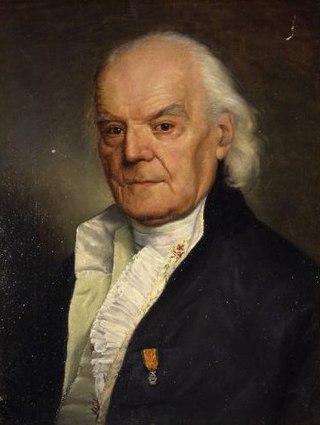
Giocondo Albertolli was a Swiss-born architect, painter, and sculptor who was active in Italy during the Neoclassical period.

Villas and palaces in Milan are used to indicate public and private buildings in Milan of particular artistic and architectural value. Milan has always been an important centre with regard to the construction of historical villas and palaces, ranging from the Romanesque to the neo-Gothic, from Baroque to Rococo.

Piazza Cordusio is a square in central Milan, Italy. The piazza takes its name from the Cors Ducis which was located on the square during Longobard times. It is well known for its several turn-of-the-19th-century Neoclassical, eclectic and Art Nouveau buildings, banks and post offices. Even though many of these have now relocated elsewhere, it is still an important commercial square in the city and hosts the Palazzo delle Assicurazioni Generali, the Palazzo del Credito Italiano and the Palazzo delle Poste, former Borsa di Milano. Piazzale Cordusio hosts the Cordusio metro station and is the starting point of the elegant pedestrian Via Dante which leads to the imposing medieval Castello Sforzesco, or Milan Castle. Opposite to Via Dante, Cordusio borders onto Piazza Mercanti, former city centre in the Middle Ages, which leads directly to Piazza del Duomo, today's city centre.

Porta Sempione is a city gate of Milan, Italy. The name is used both to refer to the gate proper and to the surrounding district (quartiere), a part of the Zone 1 division, including the major avenue of Corso Sempione. The gate is marked by a landmark triumphal arch called Arco della Pace, dating back to the 19th century, although its origins can be traced back to a gate of the Roman walls of Milan.

The Palazzo Estense is a Baroque palace built for Francesco III d'Este and the House of Este in Varese, Italy.
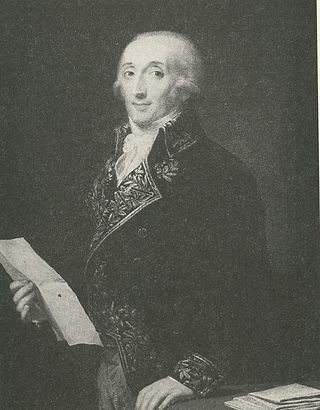
Francesco Melzi d'Eril, Duke of Lodi, Count of Magenta was an Italian politician and patriot, serving as vice-president of the Napoleonic Italian Republic (1802–1805). He was a consistent supporter of the Italian unification ideals that would lead to the Italian Risorgimento shortly after his death.

Palazzo Marino is a 16th-century palace located in Piazza della Scala, in the centre of Milan, Italy. It has been Milan's city hall since 9 September 1861. It borders on Piazza San Fedele, Piazza della Scala, Via Case Rotte and Via Tommaso Marino.
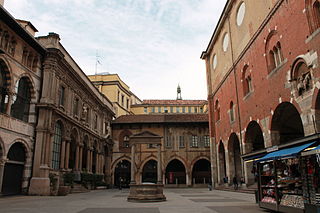
Piazza Mercanti is a central city square of Milan, Italy. It is located between Piazza del Duomo, which marks the centre of the modern city of Milan, and Piazza Cordusio, and it used to be the heart of the city in the Middle Ages. At the time, the square was larger than it is now and known as "Piazza del Broletto", after the "Broletto Nuovo", the palace that occupied the centre of the square. In the 13th century, there were six entry points to the square, each associated to a specific trade, from sword blacksmiths to hat makers.

The Biblioteca Nazionale Braidense or Braidense National Library, usually known as the Biblioteca di Brera, is a public library in Milan, in northern Italy. It is one of the largest libraries in Italy. Initially, it contained large historical and scientific collections before it was charged with the legal deposit of all publications from Milan. Since 1880, it has had the status of a national library and is today one of the 47 Italian State libraries.
Carlo Prajer or Carlo Prayer was a late 18th- and early 19th-century painter and engraver. He was born in Milan, and active in Lombardy. A pupil of Andrea Appiani, he became director of the Accademia Carrara in Bergamo. He painted four canvases designed by Giuseppe Bossi depicting the Life of Leonardo for the Villa Melzi d'Eril in Bellagio.
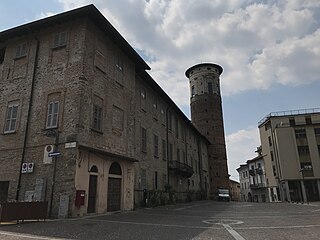
The Palazzo Prinetti is a palace located in the town of Merate, in the Province of Lecco, in the Region of Lombardy, Italy.
The Villa Litta Modignani is a 17th-century rural palace and park located on Via Taccioli in the north suburbs of Milan, in the Province of Milan, Lombardy, Italy.
The Palazzo del Podestà, or Palazzo del Broletto, is a 13th-century palace, located between Piazza delle Erbe and Piazza Broletto, in the center of Mantua, region of Lombardy, Italy. The building for many years serving as the offices of the Municipality. The main facade faces Piazza Broletto.
Melzi was a civitas (town) of the Roman Empire during late antiquity. Melzi may also refer to:
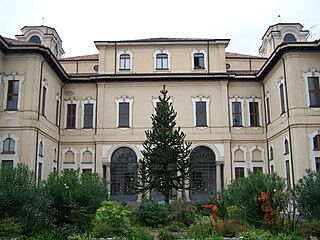
The Palazzo Brentano is a late Baroque palace on Vicolo del Ghiaccio in the town of Corbetta located in the Metropolitan City of Milan in the Italian region of Lombardy.
45°28′31″N9°11′41″E / 45.4752°N 9.1946°E